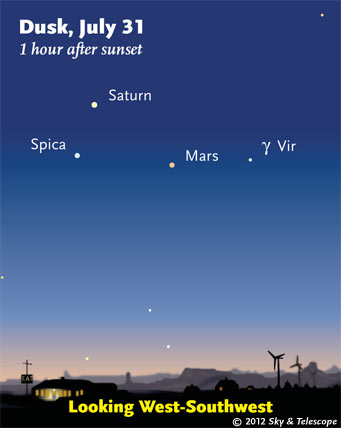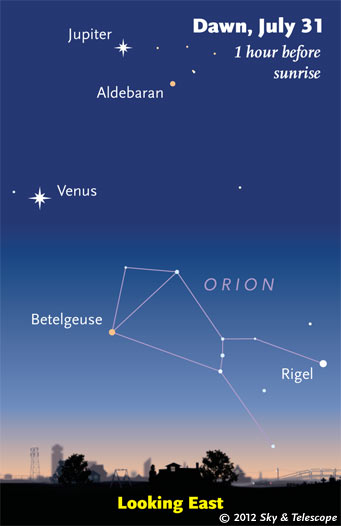
All week, watch Mars move in on Saturn and Spica at dusk.
Sky & Telescope diagram
Friday, July 27
Saturday, July 28
Sunday, July 29
Monday, July 30
Tuesday, July 31
Wednesday, August 1
Thursday, August 2
Friday, August 3
Saturday, August 4
Want to become a better amateur astronomer? Learn your way around the constellations. They're the key to locating everything fainter and deeper to hunt with binoculars or a telescope.
For an easy-to-use constellation guide covering the whole evening sky, use the big monthly map in the center of each issue of Sky & Telescope, the essential magazine of astronomy. Or download our free Getting Started in Astronomy booklet (which only has bimonthly maps).
Sky Atlas 2000.0 (the color Deluxe Edition is shown here) plots 81,312 stars to magnitude 8.5. That includes most of the stars that you can see in a good finderscope, and typically one or two stars that will fall within a 50× telescope's field of view wherever you point. About 2,700 deep-sky objects to hunt are plotted among the stars.
Alan MacRobert
Once you get a telescope, to put it to good use you'll need a detailed, large-scale sky atlas (set of charts). The standards are the little Pocket Sky Atlas, which shows stars to magnitude 7.6; the larger and deeper Sky Atlas 2000.0 (stars to magnitude 8.5); and the even larger Uranometria 2000.0 (stars to magnitude 9.75). And read how to use sky charts effectively.
You'll also want a good deep-sky guidebook, such as Sue French's Deep-Sky Wonders collection (which includes its own charts), Sky Atlas 2000.0 Companion by Strong and Sinnott, the bigger Night Sky Observer's Guide by Kepple and Sanner, or the classic if dated Burnham's Celestial Handbook.
Can a computerized telescope replace charts? I don't think so — not for beginners, anyway, and especially not on mounts and tripods that are less than top-quality mechanically (able to point with better than 0.2° repeatability). As Terence Dickinson and Alan Dyer say in their invaluable Backyard Astronomer's Guide, "A full appreciation of the universe cannot come without developing the skills to find things in the sky and understanding how the sky works. This knowledge comes only by spending time under the stars with star maps in hand."
This Week's Planet Roundup

Bright Jupiter and brighter Venus are pulling away from each other in the eastern sky at dawn.
Sky & Telescope diagram
Mercury is out of sight in conjunction with the Sun.
Venus and Jupiter (magnitudes –4.6 and –2.2) shine dramatically in the east before and during dawn, as shown at right. They've widened to about 14° apart now, with Jupiter higher. Look for Aldebaran, much fainter, lower right of Jupiter. Also near Jupiter are the Hyades, and higher above are the Pleiades.
The asteroids Ceres and Vesta, magnitudes 9.1 and 8.4, are in the area too! See article and finder charts: Ceres and Vesta, July 2012 – April 2013.
Mars and Saturn (magnitudes +1.1 and +0.8, respectively) are low in the west-southwest at dusk. Saturn stands 4½° above similarly-bright Spica. Mars is approaching closer to them every day and will pass between them on August 13th and 14th.
Uranus (magnitude 5.8, at the Pisces-Cetus border) and Neptune (magnitude 7.8, in Aquarius) are high in the southern sky before the first light of dawn. Finder charts for Uranus and Neptune.
All descriptions that relate to your horizon — including the words up, down, right, and left — are written for the world's mid-northern latitudes. Descriptions that also depend on longitude (mainly Moon positions) are for North America. Eastern Daylight Time (EDT) equals Universal Time (also known as UT, UTC, or GMT) minus 4 hours.
Like This Week's Sky at a Glance? Watch our weekly SkyWeek TV short. It's also playing on PBS!
To be sure to get the current Sky at a Glance, bookmark this URL:
http://SkyandTelescope.com/observing/ataglance?1=1
If pictures fail to load, refresh the page. If they still fail to load, change the 1 at the end of the URL to any other character and try again.
 0
0
Comments
You must be logged in to post a comment.